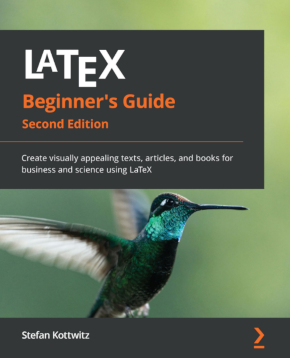Book Review: LaTeX Beginner’s Guide — Second Edition
LianTze · November 16, 2021Review by LianTze Lim
In my role as one of the technical reviewers for the second edition of LaTeX Beginner’s Guide by Stefan Kottwitz, I was privileged to see the book during its development phase so it was interesting to have an opportunity to review the finished product and check out the online resources now available to support it. Stefan is a well-known figure in the TeX/LaTeX community who has extensive experience providing online support for new LaTeX users and runs numerous TeX-related websites (see https://latexguide.org/).
LaTeX is a challenging subject to write about so it is pleasing to see the author’s user-support experience reflected in the friendly and highly accessible style in which the book is written. The book’s thoughtful design and layout also contribute to making the book feel approachable, which is an important consideration for those taking their first tentative steps into LaTeX-based typesetting. My view is that this book’s content does justice to its title, providing LaTeX users with an excellent guide, and companion, as they journey to LaTeX competence, and beyond, so I have no hesitation in recommending it.
The author’s choice of topics to form the basis for individual chapters are sensible and resonate strongly with my personal experience of providing Overleaf’s support to LaTeX users. All the essential subjects are considered, including creating tables, importing images, bibliographies and referencing, producing table of contents (and other list types), using fonts and much else besides—you can see a full list of chapters, and some sample content, on the publisher’s web page for this book.
Leveraging the sensible choice of topics, the author systematically dissects LaTeX’s learning curve with clear explanations, numerous helpful examples and attention to important concepts along the way, providing more than the essential basics and going further than many online LaTeX tutorials. Within the book the LaTeX examples are backed by ample explanations which help the reader gain confidence and build firm foundations on which to develop their understanding of LaTeX. The author encourages readers to try out the code themselves, to get a “real” feel of what works, what doesn’t, and what changes from one example to the next, as the author builds up learning points from previous sections.
Although readers can quickly try out the examples by copy and paste into Overleaf or via the book’s companion website, I recommend systematically working through the book and manually typing out the example code in Overleaf (or your favorite LaTeX editor) to see the effect of each code change. Physically typing LaTeX code, then fixing your typos, is an invaluable way to build your “muscle memory”, as opposed to easier and immediate gratification achieved from copy and paste. Even if you have had some experience with LaTeX before reading LaTeX Beginner's Guide, you may still find many useful nuggets in the examples and explanations, gaining better insight to common misunderstandings about how LaTeX works!
The following sections note some personal highlights of the book.
Covers using Overleaf! and Writefull
The first chapter shows how to get started with LaTeX—covering installation of TeX Live (for the intrepid) and, we are delighted to confirm, discusses Overleaf as a much easier option for accessing a full LaTeX system without the overhead of managing your own installation. The author lists the benefits of using Overleaf and shows how to create your first document online. As a bonus, the Writefull Overleaf extension is also covered, as a means to check grammar and provide phrasing suggestions for your text. It's a very comprehensive introduction.
Fixing LaTeX errors
Writing as a member of the Overleaf Support Team, I am delighted to see an entire chapter, Chapter 13: Troubleshooting, being devoted to finding and fixing LaTeX errors. This chapter helps LaTeX users develop a very, very important skill: taking notice of any LaTeX error and warning messages, which might arise from a LaTeX compilation run, and developing techniques to identify and troubleshoot the source of those errors (or warnings). Diagnosing the source of LaTeX errors is not always an easy task but this chapter will certainly give you a solid starting point for developing this essential skill.
Online resources
The first edition of LaTeX Beginner's Guide was published in 2011, and the ensuing decade has seen many developments in the LaTeX ecosystem, making this second edition a welcome update for anyone taking their first steps in LaTeX. Users new to LaTeX can utilize the online resources provided to support the book: a companion website where you can explore, edit and compile the book’s LaTeX examples, together with a GitHub repository where updated versions of the LaTeX examples will be published.
Book details
- Title: LaTeX Beginner’s Guide — Second Edition
- Author: Stefan Kottwitz
- Publication date: October 2021
- Publisher: Packt
- Pages: 354
For more information visit the publisher’s web page for this book.
Disclaimer
LianTze Lim is Community TeXpert at Overleaf and has been supporting Overleaf users with LaTeX-related questions since 2014. Prior to publication of LaTeX Beginner’s Guide — Second Edition, LianTze provided technical reviews of early drafts but did so in a personal capacity and in her own time. Overleaf has had no involvement with authorship of, nor any editorial input into, the content of LaTeX Beginner’s Guide — Second Edition.
